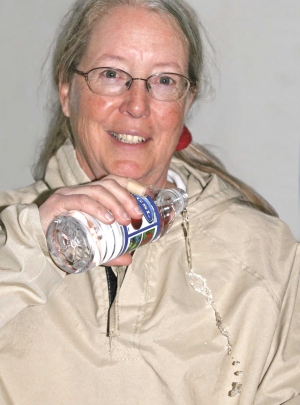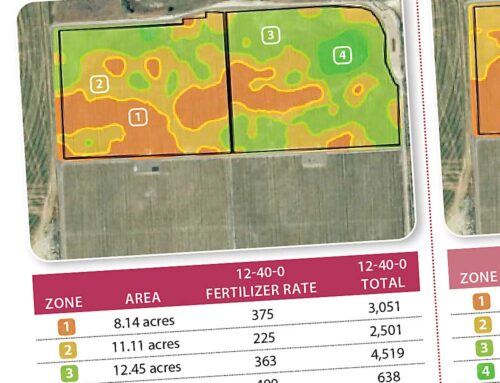
Carol Black demonstrates the water repellency of a certified garment worn in Brazil by pesticide applicators. (Melissa Hansen/Good Fruit Grower)
Is there better clothing for protection while spraying pesticides? Washington State University’s Carol Black is working with the state’s tree fruit industry and others to find out.
Black, who works on national pesticide policy issues as a WSU education specialist, became interested in the clothing aspect when she noticed that pesticide labels of the European Union and Brazil specify that “certified” garments be worn by pesticide applicators.
“In Brazil, pesticide applicators wear spray-resistant garments made of a Teflon material that repels or beads off liquid,” she said.
“The United States is behind Europe and Brazil in that we don’t actually certify the garments that applicators must wear,” she said. “Our pesticide labels say ‘wear a single or double layer of clothing’ for protection. The labels don’t say what type of material to wear. There’s no standardization in the type of garments required.”
Black received funding from the Washington Tree Fruit Research Commission to study the types of personal protective clothing used in the tree fruit industry, evaluate protective clothing requirements on pesticide labels, and work with U.S. garment manufacturers to see if protective clothing for applicators could be improved.
She worked with 13 grower-cooperators in Washington to learn industry practices and attitudes about protective clothing. She is collaborating with the University of Maryland, Washington State Department of Agriculture, and others in the project.
In reviewing the clothing requirements of hundreds of pesticide labels, she found that 85 percent of the labels require long sleeves and long pants. Most of the label emphasis is on the need for protective headgear. Very few labels—about 5 percent—required chemical-resistant garments. Of the 135 tree fruit products that were reviewed, 32 required protective headgear.
“For most products, the greatest risk is unintended exposure to the head,” Black said, noting that very few products require more than long sleeves and long pants.
Industry practices
To learn industry practices, she worked with grower-cooperators and observed pesticide applications and interviewed applicators to understand motives behind their protective clothing choices.
“Pesticide labels are very confusing and some have conflicting information,” she said. For example, one label allowed coveralls to be worn over shorts, but required chemical-resistant headgear.
In her study of industry practices, she saw all types of rain suits and Tyvek coveralls used in tree fruit operations.
“Applicators were wearing either heavy rain suits or disposable Tyvek-type material,” she said, adding that workers wore rain suits even though they weren’t required. “They wore them because they wanted protection from spray materials from things like turning at the end of rows or the wind.”
Misconception of risk
Some workers didn’t want to get their clothes or rain suit dirty, so they would wear disposable coveralls as an outer layer on top of their rain suit.
“There’s a hassle factor involved in clothing,” Black said. “Workers don’t want to hassle with cleaning their rain suit, so disposable garments may be more useful than reusable garments.”
An unexpected aspect of her study was workers’ perception of risk. Some wore rain suits because they were concerned about getting a drop of spray on their skin.
“Risk from a single drop was something they were very concerned about,” she said, noting that many products are very low in toxicity. She believes more education is needed to address these misconceptions.
Part of the project involved studies in which workers tried out garments of various liquid-repellent and liquid-proof materials. She collected comfort and durability information and is working with U.S. garment manufacturers to improve protective clothing.
“We tried things like lightweight Tyvek garments with taped seams that are more liquid proof than some disposable coveralls but lighter in weight than rain suits,” she said.
Black is working with Oklahoma State University researchers who designed a two-piece garment that may be more suitable than a one-piece coverall design.
She hopes the work leads to prototype clothing that can be tested in the field this season. •






Dear Melissa
I m looking forward to do a doctorate in protective clothing for workers in pesticide industry…please guide. Me
We are devloping hot weather farmer clothing .
The properties we are looking for are heat proofing , water repellency , light weight fabric .